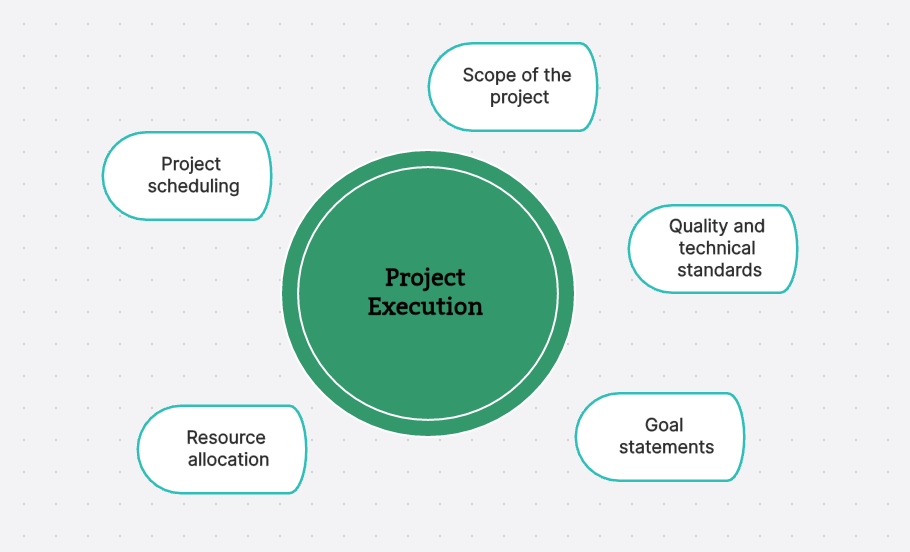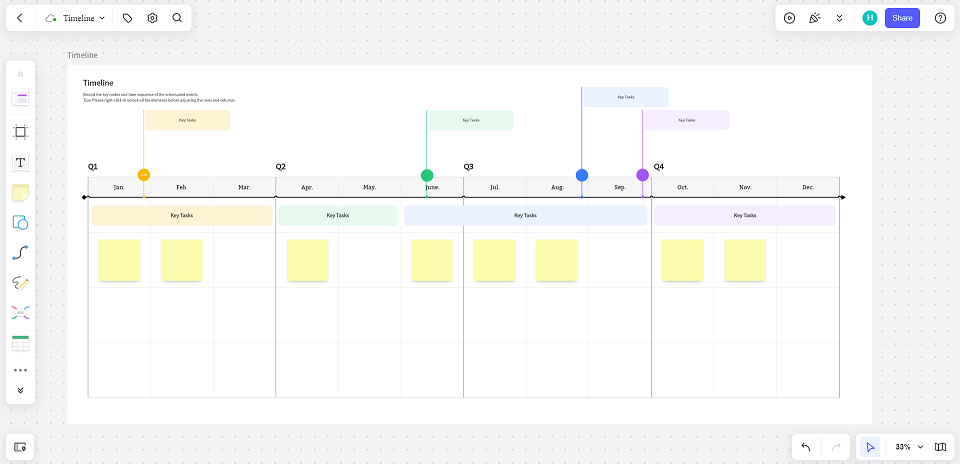Project execution is a critical phase in any project management cycle. It involves putting the project plan into action to achieve the desired outcomes. However, executing a project successfully requires a well-crafted project execution plan and effective tools to monitor progress. This article delves into the concept of project execution, its challenges, and how an online whiteboard tool like Boardmix can help streamline this process.
Part 1. What Is Project Execution?
Project execution is the phase where teams roll up their sleeves and dive into the tasks that bring the project plan to life. This stage is more than just ticking off tasks on a checklist; it's about managing people, marshalling resources, and orchestrating procedures to achieve the set objectives within the stipulated time frame.
The success of this stage hinges on several key factors. Effective communication is paramount - team members need to be clear about their roles, responsibilities, and deadlines. Coordination is another crucial element - ensuring all moving parts of the project are working in harmony towards a common goal. Problem-solving skills among team members are also vital as unexpected issues or roadblocks can arise at any point during project execution.
Moreover, project execution isn't a linear process; it often requires flexibility and adaptability from all team members. As projects evolve, teams may need to adjust their approach or tactics, making agility an essential trait for successful project execution.
In essence, project execution is where planning meets action. It's where strategies are put to test and ideas transform into tangible results. It's a dynamic and challenging phase but with effective management and strong teamwork, it can lead to successful completion of projects.
Part 2. What Is a Project Execution Plan?
A Project Execution Plan (PEP) is not just a strategic document, but the cornerstone of any project that outlines in detail how the project will be carried out. It's akin to a blueprint for action, providing a clear path from project initiation to completion.
The PEP includes comprehensive details about deliverables - what needs to be produced or achieved at each stage of the project. It also outlines timelines, setting clear expectations for when each task or milestone should be completed. This helps keep everyone on track and ensures that the project progresses in a timely manner.
In addition, the PEP specifies resources required for the project, including human resources, materials, technology and financial resources. By identifying these needs upfront, teams can plan effectively and avoid potential bottlenecks down the line.
Risk management strategies are another crucial component of the PEP. Every project comes with its own set of risks and uncertainties; having a well-thought-out risk management plan can help mitigate these risks and ensure that they don't derail the project.
Communication plans are also included in the PEP. These outline how information will be shared among team members and stakeholders throughout the course of the project. Effective communication is key to ensuring everyone is aligned and working towards common goals.
Fundamentally speaking, a well-defined PEP serves as both a roadmap and compass for teams - guiding them towards successful completion of projects while helping navigate any obstacles that might arise along the way. It's an indispensable tool for effective project execution.
Part 3. Challenges in Project Execution
1. Scope Creep
This refers to the uncontrolled changes or continuous growth in a project’s scope after its initiation. It's like an unwelcome guest that subtly intrudes into the project, adding new dimensions or requirements that were not part of the original plan. This can happen due to various reasons such as changing client demands, unclear initial project goals, or lack of proper communication among team members. The consequences of scope creep are often detrimental, leading to delays as teams scramble to accommodate these new changes. Moreover, it can also result in cost overruns as additional resources might be needed to meet the expanded scope. In essence, unchecked scope creep can derail a project from its intended path and jeopardize its successful completion.
2. Execution Gap
The term "Execution Gap" refers to the discrepancy between what was meticulously planned during the project planning phase and what is actually achieved during project implementation. It's like setting out on a journey with a well-drawn map, only to find that the actual path differs from what was charted.
This gap can arise due to various reasons - unforeseen challenges, unrealistic planning, lack of resources, or ineffective communication among team members. The execution gap is not just about missed deadlines or unmet targets; it also reflects in the quality of work produced. If the end result doesn't align with the initial vision or meet the expected standards, it signifies an execution gap.
Addressing this gap requires thorough analysis to identify its root causes and implementing corrective measures. This could involve revisiting the project plan, adjusting strategies, improving communication channels or even providing additional training to team members if needed.
In essence, understanding and managing the execution gap is crucial for successful project management as it directly impacts the efficiency of processes and overall project outcomes.
Part 4. How to Close a Project Execution Gap
Closing an execution gap is akin to bridging the divide between vision and reality in project management. It requires proactive planning and vigilant monitoring measures, which are not just one-time activities but continuous processes throughout the project lifecycle.
Setting clear and realistic goals is the first step towards closing an execution gap. These goals should be Specific, Measurable, Achievable, Relevant, and Time-bound (SMART). They provide a clear direction for the team and serve as a benchmark against which progress can be measured.
Maintaining open communication channels is another crucial aspect. This ensures that all team members are on the same page regarding project expectations and any changes in plans or strategies. Regular feedback sessions can help identify potential issues early on and make necessary adjustments before they escalate into major problems. Updates about project status should also be shared regularly with all stakeholders to keep them informed about the progress made and challenges encountered.
Regular progress tracking against set milestones is also essential. This involves comparing actual performance with planned performance at regular intervals to identify any deviations. If a task is falling behind schedule or exceeding its budget, immediate corrective actions can be taken to bring it back on track.
In addition to these, fostering a culture of accountability among team members can also help close execution gaps. When each member takes ownership of their tasks and responsibilities, it increases their commitment towards achieving project goals.
Lastly, learning from past projects can provide valuable insights for future ones. Post-project reviews should be conducted to identify what worked well and what didn't, so that lessons learned can be incorporated into future project planning and execution strategies.
Part 5. How to Monitor Project Execution with Boardmix
Boardmix is a cutting-edge online whiteboard tool, specifically designed to revolutionize the way teams collaborate and visualize ideas during project planning and execution phases. It serves as a digital canvas where ideas can be mapped out, strategies can be drawn, and progress can be tracked visually. With its intuitive interface and robust features, Boardmix not only facilitates efficient collaboration but also injects dynamism into project management processes, making them more interactive and engaging. Whether it's brainstorming sessions, workflow diagrams or progress tracking, Boardmix is your go-to tool for effective project visualization.
Here are ways Boardmix can help:
- Real-time Collaboration: Team members can work together simultaneously on tasks.
- Visual Planning: Use various templates for brainstorming sessions or strategy mapping.
- Progress Tracking: Keep track of task completion status easily.
- Feedback Sharing: Instantly share thoughts or suggestions through comments or annotations.
Conclusion
Effective project execution is a complex process that demands meticulous planning and vigilant monitoring. While this can be challenging, it's not an insurmountable task with the right tools at your disposal! Enter Boardmix - a game-changer in the realm of project management. It's designed to streamline collaboration, enhance visualization and boost productivity in your projects. With its robust features and user-friendly interface, Boardmix empowers teams to navigate through project phases seamlessly. So why wait? Embrace Boardmix today and experience a significant uplift in your project execution efficiency and team productivity!








